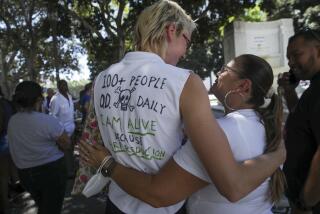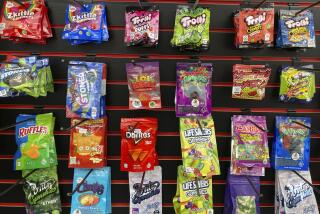Illicit Drug Use by High School Students Drops : Narcotics: Teen-agers surveyed report reduced consumption of powdered cocaine. But, the number of regular crack smokers changes very little.
- Share via
WASHINGTON — In a new indication of a declining American appetite for illicit highs, a federal study has found that the use of drugs by high school students continued to decline last year even as the availability of the substances appeared to increase.
While the Bush Administration hailed the new findings as evidence of success in curbing the demand for drugs, its top anti-drug official warned that the government still must muster its energies behind efforts designed to cut off their supply.
“More work needs to be done on the supply side,” said drug czar William J. Bennett, underscoring the Administration agenda for this week’s summit in Cartagena, Colombia, where U.S. officials hope to reinvigorate an anti-drug offensive “where the coca is.”
The latest survey by the National Institute on Drug Abuse confirmed that broad trends toward declining drug use are continuing, but it also showed that the reductions were becoming less steep and that the number of frequent users of crack cocaine remained about constant.
The proportion of high school seniors who said they had used drugs within the last year dropped to 35.4%, the lowest figure since the closely watched surveys began in 1975.
The percentage of students who acknowledged using cocaine within the previous month decreased to 2.8% in 1989 from 3.4% in 1988--a smaller decline than the year before. Almost all of last year’s decline appeared to be in use of powdered cocaine, with regular crack users essentially unchanged at 1.4% of those surveyed.
Meanwhile, the proportion of students who said cocaine would be “fairly easy” or “very easy” for them to get climbed to 58.7%, an all-time high.
Researchers said the survey indicated that drug use among hard-core users has persisted in defiance of an otherwise widespread shift in national behavior. It also suggested that future reductions in usage are likely to be smaller than the dramatic declines of past years.
“The further down we go, the more difficult it will be,” said Frederick K. Goodwin, a senior official at the Department of Health and Human Services.
Bennett, the architect of a new Administration strategy designed to curb drug use, described the findings as a “welcome sign that progress against the drug problem can be made.” The slow-down in the rate of decline, however, showed that “the work may now get harder,” he said.
The conclusion that drug use has continued to fall, which was based primarily on a survey of some 17,000 high school seniors, was supported by the findings of a companion study of about 10,000 high school graduates. The latest disclosures follow last summer’s release of a major national institute survey that found the number of regular drug users in American households had declined by 37% from 1985 to 1988.
“Demand is changing,” said University of Michigan researcher Lloyd Johnston, who headed the survey of high school seniors and cited the likely influence of anti-drug peer pressure, media coverage and drug education programs.
Noting that the President’s anti-drug strategy has aimed in large part at curbing demand, Bennett and other officials emphasized at a White House briefing Tuesday that the Administration would continue those efforts.
“We are on the right course,” said Louis W. Sullivan, secretary of health and human services, “and we must not allow our efforts to slacken.”
But Bennett, a longtime champion of law enforcement efforts aimed at staunching the flow of cocaine, said he found “particularly disturbing” the parallel indications that the drug remained readily available even to high school students.
The latest indications of a gradual decline in drug use held true for nearly every illicit substance, including marijuana, LSD and cocaine. The only significant increase was in the use of PCP, with current use reported up from 0.3% to 1.4% in the past year. Federal officials said they were concerned by the upsurge.
The researchers who conducted the latest high school study acknowledged that it may tend to underestimate the exact rate of drug use because it is based on self-reporting by students and is not administered to dropouts.
But they said that studies of frequent truants--regarded as “near dropouts”--have also shown overall declines in consumption of illicit drugs.
As secretary of health, Sullivan expressed particular concern that the use of tobacco and alcohol by high school students has failed to decline at a similar pace.
He noted that the survey found that 29% of high school seniors were current smokers--the same proportion as in 1981--while the percentage of those who had used alcoholic beverages in the last month was 60%, only a modest decline from a 72% peak in 1980.
More to Read
Sign up for Essential California
The most important California stories and recommendations in your inbox every morning.
You may occasionally receive promotional content from the Los Angeles Times.













